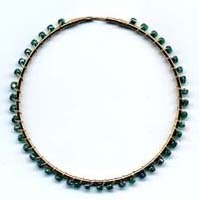Lacy Bridal Set
The ethereal design of this Lacy Bridal Set creates the look of lace. All you need is some fabulous Beadalon 49 Strand silver plated wire to evoke the look of spun silver lace. Save big and consider DIY jewelry crafts before your special day. Head to your favorite bead or art supplies store instead of a fancy jewelry store and save yourself stress and money. The pretty design and unexpected details help these designs stand out from a sea of generic DIY wedding jewelry. Save your creations and pass them down to the next generation - it's a great way to create a family heirloom.
Materials:
- Beadalon 49 Strand .018 in. silver plated wire
- 2 - 3-to-1 Victorian filigree ring-end connectors, silver plate
- 2 - Dapped and spring French ear wires, silver plate
- 7mm Medium spring ring clasp, silver plate
- 2 in. plus 2 links - Medium curb chain, silver plate
- 14 - 24 gauge 1 in. Head pins, silver plate
- Small toggle clasp
- 12 - Size #2 Crimp tubes, sterling or silver plate
- 81 - 6mm Clear A/B glass bicone faceted beads
- 28 - 8mm Créme round imitation pearl coated glass beads
- Designer crimper
- Designer round nose pliers
- Designer chain nose pliers
- Designer flush cutter
Instructions:
Lacy Bridal Choker
- Begin with a 24 in. length of silver plated wire. Add two bicone beads to one end. Loop the wire over the beads and thread it back through the two beads to create a loop. Tighten enough to keep the beads secure and leave an exposed wire loop.
- Repeat the looping process described in step 1, but leave the loop on the opposite side, mirroring the first loop. The wire will create a serpentine "S" shape as the design progresses.
- Continue along the choker until you reach the end - 28 stations and 56 bicone beads. Check back over the design for continuity before finishing. The loops should all be of consistent size.
- Using a crimp tube, attach one end to the 2 in. length of curb chain.
- Using a crimp tube, attach the other end of the strand to the spring ring clasp.
- Thread 14 pearls onto 14 head pins and loop each one, trimming the excess wire.
- Attach the pearly head pins to the bottom loop (every other station of two bicones) of each "S" curve. Use pliers to open and close the loops securely.
- For an elegant, professional touch, add one bicone crystal looped on a head pin loop to the end of the curb chain. A little extra sparkle adds a radiant finishing touch.
Designer Hint: Open and close jump rings and wire loops to the side rather than pulling them apart; this will cause less stress on the wire. And less stress means better longevity for the whole piece.
Lacy Bridal Earring
- Using 3 in. segments of silver plated wire, create two 2-loop stations, finishing the ends with a secured crimp tube. Use a crimp tool to make sure that your tubes are completely securing the wire ends.
- Add one looped headpin with an 8mm pearl to the bottom of each 2-loop segment.
- Attach an ear wire to each segment. The earrings should be mirror images: oppose the direction of each earring for a more professional look.
Lacy Woven Bridal Bracelet
- Using crimp tubes and a crimp tool, attach three 12 in. strands of silver plated wire to a 3-to-1 Filigree connector.
- Thread one pearl on each of the two outside strands.
- Thread two bicones on the center strands.
- Thread all three strands through one bicone bead.
- Continue with this pattern, tightening as you go to create tension, until the strand comprises 6 total groups of beads.
- Check through the piece to tighten it before crimping. The 2 pearls should rest on top of and between the two bicones, leaving some exposed wire.
- Using crimp tubes, attach the three strands to a second 3-to-1 Filigree connector.
- Use a jump ring to attach the circle portion of the toggle clasp to one 3-to-1 Filigree connector. Attach the toggle clasp bar to the other 3-to-1 Filigree connector using the two chain links.
Note:
- To complete this project, you will need to be familiar with crimping beads in place on wire, head pin turning, opening and closing metal rings, and weaving stranded wires. The key to weaving with wire is working carefully to maintain the proper tension while moving along the design. Take time to adjust tension before finishing of the ends.
Read Next3 Minute Sea Glass Rings

















